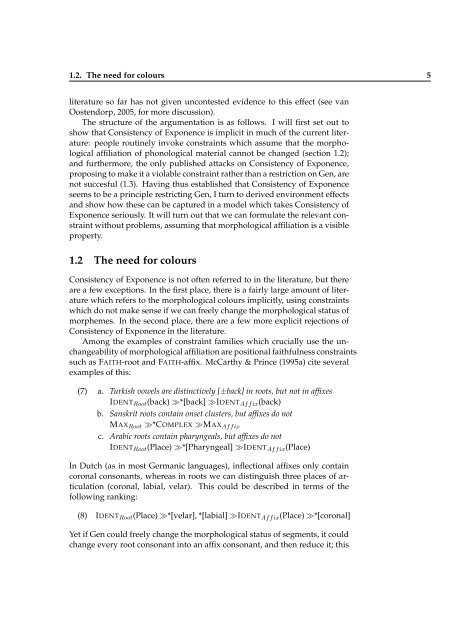Derived Environment Effects and Consistency of ... - Linguistics
Derived Environment Effects and Consistency of ... - Linguistics
Derived Environment Effects and Consistency of ... - Linguistics
You also want an ePaper? Increase the reach of your titles
YUMPU automatically turns print PDFs into web optimized ePapers that Google loves.
1.2. The need for colours 5<br />
literature so far has not given uncontested evidence to this effect (see van<br />
Oostendorp, 2005, for more discussion).<br />
The structure <strong>of</strong> the argumentation is as follows. I will first set out to<br />
show that <strong>Consistency</strong> <strong>of</strong> Exponence is implicit in much <strong>of</strong> the current literature:<br />
people routinely invoke constraints which assume that the morphological<br />
affiliation <strong>of</strong> phonological material cannot be changed (section 1.2);<br />
<strong>and</strong> furthermore, the only published attacks on <strong>Consistency</strong> <strong>of</strong> Exponence,<br />
proposing to make it a violable constraint rather than a restriction on Gen, are<br />
not succesful (1.3). Having thus established that <strong>Consistency</strong> <strong>of</strong> Exponence<br />
seems to be a principle restricting Gen, I turn to derived environment effects<br />
<strong>and</strong> show how these can be captured in a model which takes <strong>Consistency</strong> <strong>of</strong><br />
Exponence seriously. It will turn out that we can formulate the relevant constraint<br />
without problems, assuming that morphological affiliation is a visible<br />
property.<br />
1.2 The need for colours<br />
<strong>Consistency</strong> <strong>of</strong> Exponence is not <strong>of</strong>ten referred to in the literature, but there<br />
are a few exceptions. In the first place, there is a fairly large amount <strong>of</strong> literature<br />
which refers to the morphological colours implicitly, using constraints<br />
which do not make sense if we can freely change the morphological status <strong>of</strong><br />
morphemes. In the second place, there are a few more explicit rejections <strong>of</strong><br />
<strong>Consistency</strong> <strong>of</strong> Exponence in the literature.<br />
Among the examples <strong>of</strong> constraint families which crucially use the unchangeability<br />
<strong>of</strong> morphological affiliation are positional faithfulness constraints<br />
such as FAITH-root <strong>and</strong> FAITH-affix. McCarthy & Prince (1995a) cite several<br />
examples <strong>of</strong> this:<br />
(7) a. Turkish vowels are distinctively [±back] in roots, but not in affixes<br />
IDENTRoot(back) ≫*[back] ≫IDENTAffix(back)<br />
b. Sanskrit roots contain onset clusters, but affixes do not<br />
MAXRoot ≫*COMPLEX ≫MAXAffix<br />
c. Arabic roots contain pharyngeals, but affixes do not<br />
IDENTRoot(Place) ≫*[Pharyngeal] ≫IDENTAffix(Place)<br />
In Dutch (as in most Germanic languages), inflectional affixes only contain<br />
coronal consonants, whereas in roots we can distinguish three places <strong>of</strong> articulation<br />
(coronal, labial, velar). This could be described in terms <strong>of</strong> the<br />
following ranking:<br />
(8) IDENTRoot(Place) ≫*[velar], *[labial] ≫IDENTAffix(Place) ≫*[coronal]<br />
Yet if Gen could freely change the morphological status <strong>of</strong> segments, it could<br />
change every root consonant into an affix consonant, <strong>and</strong> then reduce it; this

















